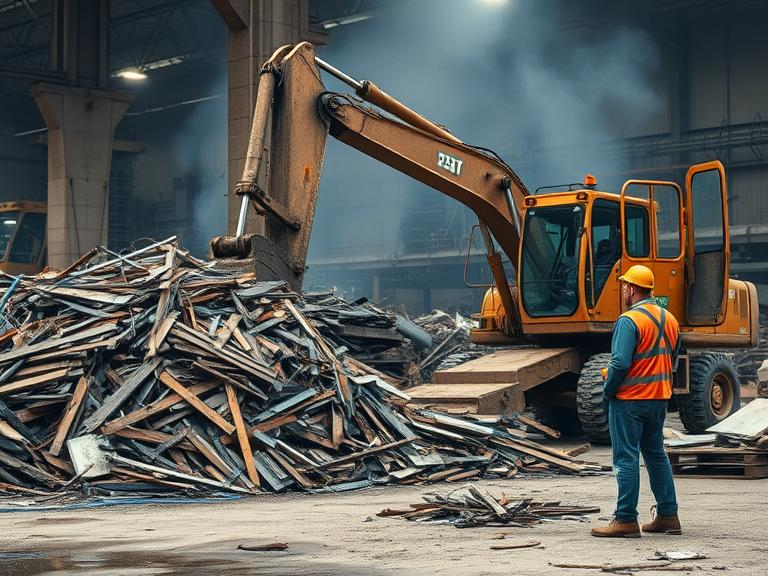Scrap Metal: Guide to Recycling, Value, and Environmental Impact
- Kiara Waylen

- Sep 10, 2025
- 4 min read
In today’s world of increasing environmental awareness and resource conservation, scrap metal recycling has emerged as a vital industry. Whether you're cleaning out a garage, running a construction site, or managing a manufacturing plant, scrap metal offers both environmental and financial benefits.

In this comprehensive guide, we’ll explore what scrap metal is, the types of metals commonly recycled, how the process works, and why scrap metal recycling is good for your wallet—and the planet.
What Is Scrap Metal?
Scrap metal refers to any metal material that is no longer useful in its current form but can be recycled and repurposed. This includes everything from old car parts and appliances to copper wires and industrial equipment. Unlike other waste materials, metal retains its properties and value even after being recycled multiple times.
There are two main categories of scrap metal:
Ferrous Metals: Contain iron and are magnetic (e.g., steel, cast iron).
Non-Ferrous Metals: Do not contain iron and are non-magnetic (e.g., aluminum, copper, brass, lead).
Common Types of Scrap Metal
Knowing the types of scrap metal can help you identify valuable materials and maximize your recycling returns.
1. Aluminum
Found in soda cans, window frames, car parts, and siding. Lightweight and corrosion-resistant, aluminum is one of the most commonly recycled metals.
2. Copper
Highly valuable due to its conductivity and durability. Often found in electrical wires, plumbing pipes, and roofing materials.
3. Brass
A yellowish alloy of copper and zinc, commonly used in plumbing fixtures, doorknobs, and musical instruments.
4. Steel
A ferrous metal used in everything from appliances and cars to building materials. It’s heavy, durable, and widely recycled.
5. Iron
Often found in construction and industrial scrap. Cast iron bathtubs, radiators, and cookware are common sources.
6. Lead
Used in batteries, pipes, and cable sheathing. Lead must be handled carefully due to its toxicity.
Why Recycle Scrap Metal?
Recycling scrap metal is about more than just cleaning up clutter. It offers major advantages for the economy, the environment, and individual consumers.
1. Environmental Benefits
Reduces landfill waste: Metal doesn’t decompose, so recycling keeps it out of landfills.
Conserves natural resources: Recycling reduces the need for mining raw materials.
Saves energy: Recycling metal uses up to 95% less energy than producing new metal from ore.
Reduces greenhouse gas emissions: Less energy use means fewer carbon emissions.
2. Economic Benefits
Creates jobs: The scrap metal industry supports thousands of jobs worldwide.
Supports manufacturing: Recycled metals supply raw materials for industries at lower costs.
3. Financial Rewards
Scrap metal has real cash value. Individuals and businesses can sell their scrap to recycling centers and receive payment based on weight and type.

Where to Find Scrap Metal?
If you’re looking to collect scrap metal, here are common places to find it:
Household items: Old appliances, broken furniture, electronics, and wiring.
Construction sites: Leftover rebar, piping, and steel beams.
Automotive shops: Used car parts, radiators, and wheels.
Industrial facilities: Machinery, shelving, and production waste.
Farms: Fencing, tools, tractors, and equipment parts.
Always make sure to ask for permission before collecting scrap from someone else’s property.
How Scrap Metal Recycling Works?
The scrap metal recycling process is designed to be efficient, sustainable, and profitable:
Step 1: Collection
Scrap metal is collected from various sources, including households, businesses, construction sites, and manufacturing plants.
Step 2: Sorting
Metals are sorted by type—ferrous and non-ferrous—using magnets, sensors, or manual inspection.
Step 3: Processing
Scrap is cut, shredded, or compacted into smaller pieces to make transportation and melting easier.
Step 4: Melting
The metal is melted in large industrial furnaces designed for specific metal types.
Step 5: Purification
Impurities are removed through electrolysis or other purification methods to ensure high-quality recycled metal.
Step 6: Solidifying
The purified metal is cooled and solidified into bars, sheets, or other forms for reuse.
Step 7: Distribution
The recycled metal is sold to manufacturers to create new products, completing the recycling loop.
How Much Is Scrap Metal Worth?
The value of scrap metal depends on several factors:
Type of metal: Copper and brass are generally more valuable than steel or aluminum.
Current market prices: Prices fluctuate daily based on global demand.
Weight and purity: Heavier, cleaner scrap commands higher prices.
Average prices (as of recent market trends):
Copper: $3.00 – $4.50 per pound
Brass: $1.50 – $2.50 per pound
Aluminum: $0.40 – $1.00 per pound
Steel: $0.05 – $0.15 per pound
Check with your local scrap yard for the most accurate pricing.
Tips for Maximizing Scrap Metal Profits
If you're looking to make money from scrap metal, here are some useful tips:
Sort your metals: Separate ferrous and non-ferrous metals to get better pricing.
Clean the metal: Remove insulation, rubber, or plastic for higher purity.
Use a magnet: This helps quickly identify ferrous metals.
Know your local laws: Some regions require ID for scrap metal sales to prevent theft.
Build relationships with scrap yards: Frequent sellers may get better rates or service.
The Future of Scrap Metal Recycling
As sustainability becomes a global priority, scrap metal recycling is set to play an even larger role in the circular economy. Innovations in sorting, purification, and repurposing technologies are making recycling faster, cheaper, and more environmentally friendly.
Governments and industries around the world are investing in scrap metal programs to reduce reliance on raw materials and limit environmental damage.
Conclusion
Scrap metal isn’t just trash—it’s a valuable resource that contributes to sustainability, economic growth, and environmental preservation. By recycling scrap metal, individuals and businesses can turn waste into wealth while reducing their carbon footprint.
Whether you're a homeowner, contractor, or business owner, understanding the value and benefits of scrap metal recycling can make a big difference. So don’t let that old appliance or pile of wire go to waste—collect, sort, and cash in on your scrap metal today.
.png)



Comments